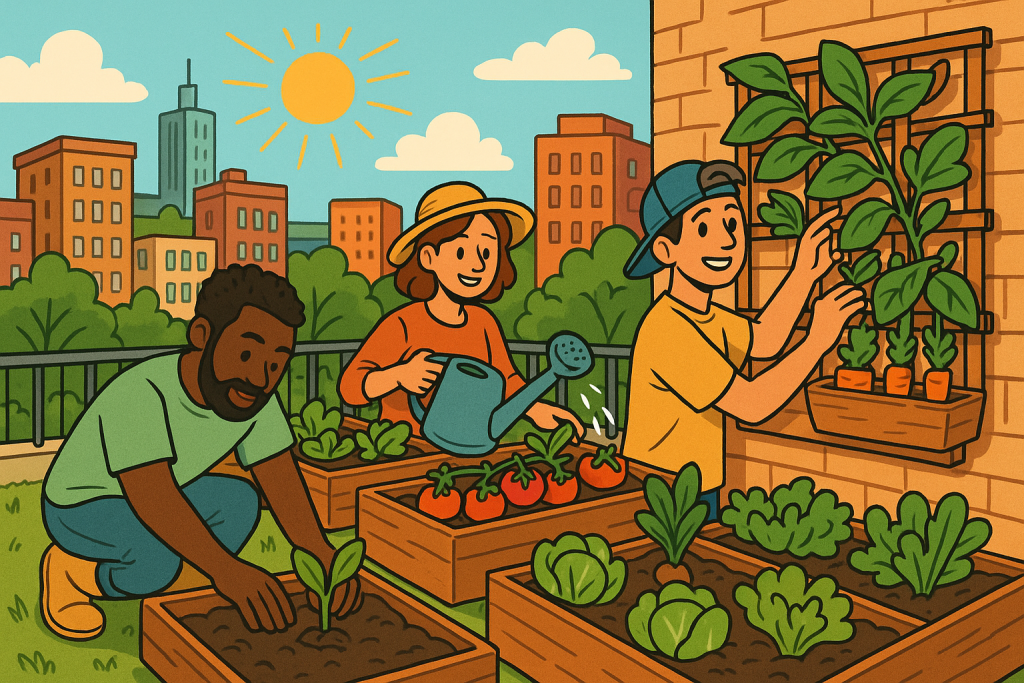Urban farming in small spaces is booming. From balconies and rooftops to window sills and vertical towers, more city dwellers are growing food right where they live. This article explores the latest trends—like vertical techniques, smart gardening, and community micro-farms—and shows how easy, beneficial, and eco-friendly they can be.

Why urban farming in small spaces is more than a trend
- The global urban farming market is projected to reach nearly 175 billion dollars by 2025, growing at ~9% annually.
- Small-scale rooftop farms and modular systems help cities fight climate change, reduce food miles, and improve resilience during extreme weather .
- Millennials and Gen Z are leading a herb‑garden revival—over 70% of 18–35‑year-olds are passionate about gardening with many growing herbs in limited spaces.
1. Balcony & Window-Sill Farming: The First Step
Even a few pots on a balcony can yield fresh herbs, veggies, and spices.
Why it works:
- Low barrier to entry: Containers, soil, and seeds—anyone can start.
- Herb favorites: Basil, mint, parsley, and thyme thrive in small pots.
- Cost savings: Avoid food waste and grocery markup—fresh basil often sells for over 3 dollars per bunch.
Tips:
- Use containers 8–14 inches deep with good drainage.
- Group plants by light needs.
- Use vertical shelves to maximize space.
- Rotate and prune to keep growth even.
2. Vertical Gardening & Living Walls
Vertical farming is revolutionizing household growing and is a key part of urban farming in small spaces.
Techniques:
- Wall-mounted stacking planters
- Hydroponic or aeroponic towers
Benefits:
- Efficient use of space—yards of plants fit in a few square feet.
- Year-round harvest, climate-control, and high yields per square foot.
- Great for small balconies, kitchens, or unused hallway walls.
3. Smart & Automated Small-Scale Systems
AI and robotics are making urban gardening easier than ever—even for beginners.
- PlantPal: precision gardening robot that works remotely to water, monitor, and engage gardeners.
- AI plant tracking systems integrate cameras and sensors to detect water stress and tune light systems.
These systems remove guesswork, ensuring beginner success—even in apartments.
4. Community Micro-Farms & Agrihoods
Neighborhood urban farms bring social, educational, and food security benefits to communities.
- Community gardens reduce crime, build social bonds, and improve mental health.
- Agrihoods like those in Arizona combine farms and homes, blending rural and urban life.
This is urban farming in small spaces with big social impact.
5. Sustainability & Environmental Gains
Urban farming in small spaces isn’t just fresh—it’s green.
- Helps cities absorb stormwater, reduce heat islands, and filter air.
- Cuts CO₂ from food transport and lowers waste by growing local.
- Encourages composting and biodiversity in concrete jungles.
6. How You Can Start Today: Step-by-Step Guide
- Assess space & light – Balcony? Kitchen ledge? Measure dimensions & sun hours.
- Select container or vertical setup – Pots or stackable planters? Choose accordingly.
- Pick your plants wisely – Herbs, cherry tomatoes, salad greens fit small areas. Many herbs grow well even in limited light.
- Prepare soil & water – Use quality potting mix with compost. Water when top inch is dry.
- Plant & care – Companion planting boosts yield (e.g., basil with tomatoes). Monitor pests and prune regularly.
- Harvest & enjoy – Use fresh produce and replant seasonally to keep your garden evergreen.
What’s Next for urban farming in small spaces
- Modular vertical farms in abandoned offices—like Eden Grow and Homer Farms are rolling out.
- AI-driven systems will become more affordable and common in 2025–30 .
- Policy support is growing: municipal recycling, rooftop farming incentives, and zero-waste guidelines pave the way.
Final Take
Urban farming in small spaces is more than a hobby—it’s food independence, sustainability, and community-building packed into a few square feet. Whether you’re an apartment dweller or community organizer, there’s never been a better time to join this green revolution. Start today—watch your small piece of the city bloom.
References
1. Sustainable Urban Agriculture: Maximizing Small-Space Potential
Nicole Paganini & Stefanie Lemke. The Potential of Urban Agriculture towards a More Sustainable Urban Food System in Food-Insecure Neighbourhoods. Economia Agro-Alimentare (2019).
https://www.tandfonline.com
2. Vertical and Urban Vegetable Farming: Innovations in Micro‑Spaces
ResearchGate. Vertical and Urban Vegetable Farming: Maximizing Small Spaces. (2023).
https://www.researchgate.net
3. Urban Agriculture’s Multi‑Dimensional Benefits & Constraints
UF/IFAS Extension. Social and Community Benefits and Limitations of Urban Agriculture. (2025).
https://edis.ifas.ufl.edu






